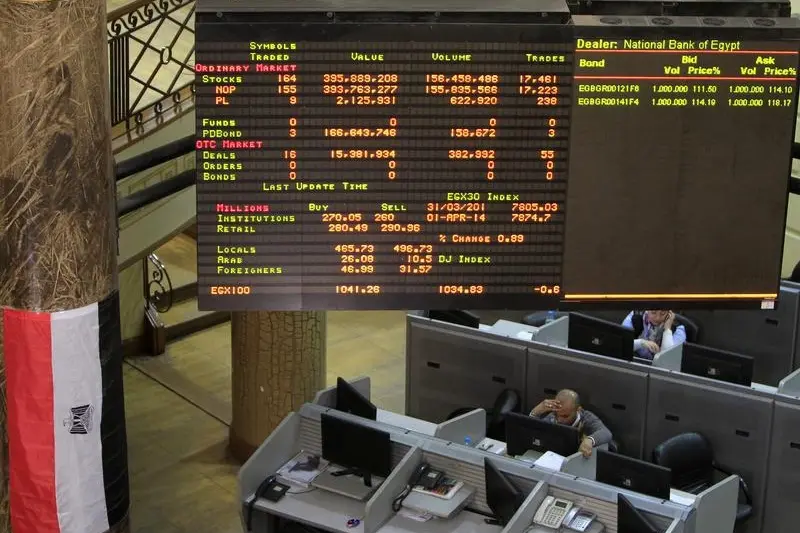PHOTO
Cairo’s main index increased in value by 21.66 percent during 2017, as a continuous drop in inflation, positive comments from the Central Bank and an ongoing programme of economic reforms boosted investor sentiment, especially in the second half of the year.
Samar Soliman of Egypt-based Okaz Stockbrokers and Investments Consultants, said: “The Egyptian Exchange’s performance in 2017 is a clear reflection of the conducted monetary policies that directly affected the performance of traded companies on the market.”
In an interview conducted via instant messaging, she said: “In 2018, we expect companies’ earnings from operating profits to affect the stock market the most. In addition to that, economic policies and investment facilities through the new investment law should positively reflect on the exchange.”
Elsewhere in the region, equity markets in the Gulf failed to match gains in emerging markets last year, which outperformed wider global capital markets, according to Kuwaiti investment management company, Kamco. In a note on Gulf markets, it reported that while the index for world markets gained 21.6 percent last year, emerging markets increased in value by 34.3 percent.
In the Middle East, although MSCI’s MENA markets index recorded a gain of 21 percent, the index of GCC markets was largely flat at 0.7 percent.
Trading activity in the GCC declined by a fifth to $303.4 billion, compared to $388 billion during 2016, according to the KAMCO report. The decline came primarily on the back of a 28 percent fall in value traded in Saudi Arabia, while markets in the United Arab Emirates recorded a decline of 14 percent.
Kunal Damle of Bahrain-based Securities & Investment Company (SICO), said via instant messaging: “2017 was a mixed year for Gulf markets, but considering how it started, it turned out well.”
Damle added: “2018 looks better, especially with the budgets aiming at growth after two-to-three years of austerity. This will trickle down into earnings growth, too.”
Saudi shows promise
Although trading values were lower, Saudi Arabia’s index edged up 0.22 percent during 2017, and a number of factors are expected to improve the fortunes of its main market this year.
FTSE Russell, the compiler of FTSE indices, is widely expected to add the Kingdom’s stock market to its global emerging markets indices in March, while MSCI is expected to make a decision in June.
The planned listing of Saudi Aramco in late 2018 should bring foreign money to the country and boost the market. This week, Saudi Arabia’s Capital Markets Authority (CMA) announced it would implement a number of rules to make it easier for foreign investors to trade in the Kingdom.
A monthly Reuters Poll conducted at the end of 2017 showed that sixty-nine percent of fund managers polled expect to increase equity allocations to the Saudi market and only eight percent plan to reduce them - the most positive balance since March 2017.
Damle said: “Saudi equity markets look good in 2018, with earnings coming in from the banking and petrochemicals sectors and supporting the market.”
He added: “MSCI and FTSE's decisions should act as technical triggers to the market.”
Markets in the UAE performed well for most of 2017 but started losing momentum in November. The Dubai Financial Market index dropped 4.55 percent over the 12-month period, while the Abu Dhabi market index lost 3.25 percent.
On UAE markets, Damle said: “We are more neutral on UAE markets in 2018 compared to Saudi Arabia and do not see earnings coming from the large market capitalisation companies. We expect the banking sector to see a rebound in earnings growth.”
According to a published Dubai Financial Market (DFM) performance report, four out of the nine indices ended the year lower in Dubai, with the ‘consumer staples’ sector being the worst performer, ending the year 52.9 percent lower.
The report also noted that foreign investment outflow from the DFM totalled almost 1.2 billion UAE dirhams ($326.7 milion).
Gains in Bahrain
Elsewhere in the Gulf, Kuwait and Bahrain’s indices both performed well, gaining 11.48 percent and 9.12 percent respectively during the year.
The Kuwaiti benchmark jumped more than 18 percent in January alone as local and regional investors took positions ahead of the government unveiling a $100 billion five-year development plan.
In contrary to most markets in the Gulf, the Kuwaiti market witnessed a doubling of trading activity in 2017 to reach $19 billion according to the KAMCO report. A note by National Bank of Kuwait analysts Chaker Al Mostafa and Nemr Kanafani said that Kuwait equities enjoyed their best performance for two years.
“The market registered healthy gains throughout most of 2017, supported by the minority share buy-out of Americana by UAE investors late in 2016, its ascension to FTSE Russel’s emerging market index and Omantel’s acquisitions of Zain stock,” the note said, adding that regional political developments in the final quarter of the year weighed down performance and led some traders to take profits.
Bahrain’s index, meanwhile, was supported by a surge in the share price of Aluminium Bahrain, which is progressing with construction of its sixth potline and this week . Its shares gained in value by almost 69 percent, while Khaleeji Commercial Bank increased in value by 48 percent. The Kamco report said that Bahrain’s commercial bank sector posted returns of 11.7 percent for the year.
(Reporting by Gerard Aoun; Editing by Michael Fahy)
© ZAWYA 2018











